Note: This research is based on the people who appear in the Property Database on Bygone Bungo, in this case the entry for 10 Moray Place, which helps give the following context. You can explore further from the Address or Person Search in the main menu.
John Angus
John was a wine and spirit merchant who had stores at Royal Arcade, 120 Sauchiehall Street, and 29 Norfolk Street in the Gorbals. He was in business from the 1850s, and when Moray Place was completed in 1862 he moved in to the large end-of-terrace property. He died at home on 1st February 1865 .
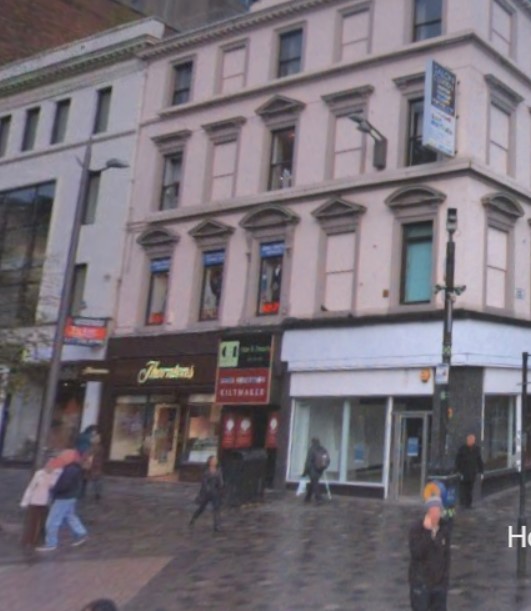
120 Sauchiehall Street, until recently a branch of Thorntons, currently The Refill Station. Credit: Bing
William Fraser
William was an employee of “N. Handyside, 92 West Regent Street” according to the PO Directory. Nicol Handyside entered business in 1838 as a shipbroker and merchant, and was the Russian vice-consul for Glasgow. He and his brother Robert, as N & R Handyside & Co, specialised in the Balkan merchant trade, and from 1850 became managers of the Glasgow & Lisbon Steam Packet Co. Soon after they adopted the name The Anchor Line. In 1855 they partnered with Capt Thomas Henderson to form Handyside & Henderson, and began a transatlantic steamer trade. The Anchor Line went on to become a leading transatlantic carrier of emigrants with a network of services from the Mediterranean to New York, as well as up to three sailings per week on its Clyde-Northern Ireland-New York service. It also became a major operator in the Glasgow-Liverpool-Mediterranean and Glasgow-Liverpool-India trades. It was eventually bought out by Cunard .
Their 1907 headquarters building by James Miller in St Vincent Place is now the Anchor Line Restaurant.
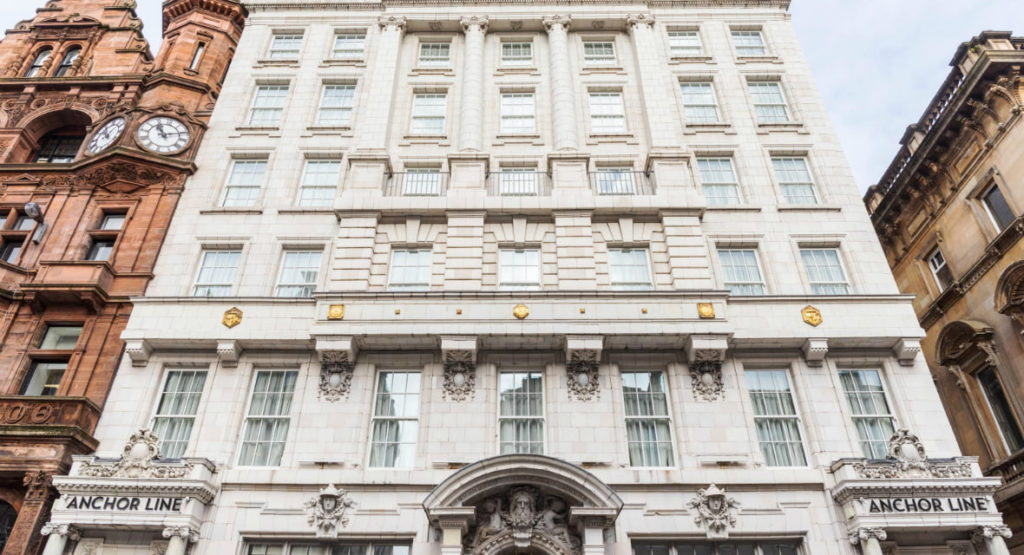
The Anchor Line HQ of 1906 by James Miller. Credit: Native Hotels
William Walker
William was a partner in Walker Brothers, merchants and manufacturers of disc and cylinder pulpers, and other coffee machinery, at 1 West Regent Street, resident here 1866.
Andrew Gray
Andrew was a drysalter, with premises at 62 St Vincent Street. He was another brief resident at No. 10, circa 1868.
Gavin Paterson
By November 1870 the house was owned by Gavin Paterson, though it was advertised for sale in the Greenock Advertiser amongst others, described as “containing Dining Room, Drawing Room, Five Bedrooms, Bath Room, Washing House, Kitchen, Scullery and Servant’s Room. In the Bath Room and Scullery there are both Hot and Cold Water Pipes” .
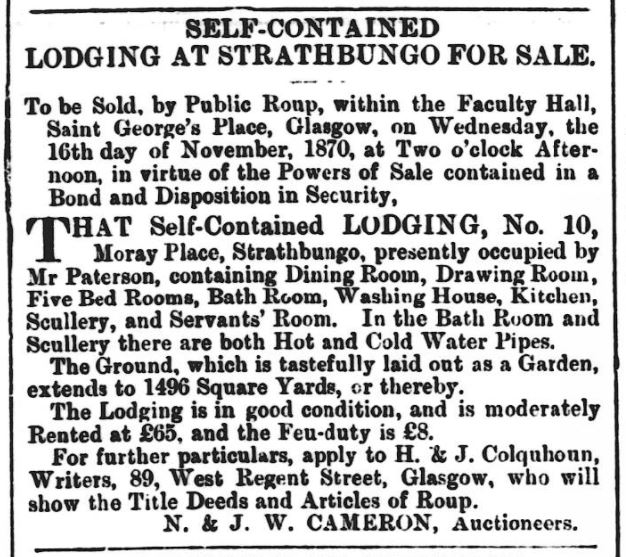
10 Moray Place for sale. Greenock Advertiser 5 November 1870.
Gavin operated the Argyle Street steam-powered boot and shoe factory; the steam power was used for rapid cutting and stitching. The enterprise employed 90 men and 25 women.
He was still resident at the time of the 1871 census, with his four daughters, Agnes, Annie, Gavina and Mary, and servant Mary Sinclair from Craignish. Gavin’s wife Annie Muirhead had died in 1869. After the sale of the house he moved to 44 (now 49) Regent Park Square, then Lorne Terrace, Pollokshields and finally Lawrie Villa, Queens Drive, Crosshill, where he died in September 1878, leaving an estate of over £14,000.
The Waddels
James Waddell (or Wadle) was born in 1808 in Whitburn, Linlithgow, the son of James Waddell, a “landed proprietor”, and Catherine Smith.
He married Mary Alston (1816-1899) from Hamilton c. 1840, and had three daughters, Jane (1840-1883), Catherine (1845-1931) and Mary Waddell (1852-1938), and two sons, James (1843-1866) and John Alston Waddell (1847-1931). The 1841 census records Mary living with James Wadle and their 7 month daughter, but under her maiden name.
The 1851 & 1861 censuses appear to record James as a cloth merchant and a linen draper in Cambusnethan near Wishaw, suggesting his interest in coal did not develop until he was in his 50s.
His eldest son James married Jane Thomson Baird in Cumbernauld in 1864, and had a daughter Barbara the following year. They appeared to have lived with his parents, but tragically James died in 1866 at the age of only 23 from a fever. His wife later remarried and had another family, but Barbara died at 8, probably of tuberculosis. By the time of James’ death the family had moved to Glasgow and were living in the tenements on Pollokshaws Road, at 4 Regent Park Terrace. His death was certified by the local GP Dr William Fenwick.
Coalmasters
James junior was recorded as a ‘coalmaster’ on his death certificate, as was his father in the 1871 census, indicating they owned or leased a coal mine by the mid 1860s, and presumably had left the linen trade behind.
In the 1871 census they were still at 4 Regent Park Terrace, although daughter Jane had married the GP Dr Fenwick in 1869, and the couple were living in the next close at 5 Regent Park Terrace.
The first reference I can find to the Waddells’ involvement in coal is the opening of Overtown Bridge Colliery near Wishaw by Waddell & Loudon in 1860, who had an office at 20 Union Street in Glasgow. Ownership then passed to Joseph Waddell, 1866-1869, and then to James Waddell in 1870-1875 . The identity of Joseph Waddell is uncertain, and so it isn’t clear what mine James and his son might have been managing previously in the 1860s, before taking charge at Overtown.
The Waddells also took over Mauldslie Colliery near Carluke around 1873 and the family managed it until at least 1890 .
Meanwhile a legal case from 1876 records a dispute between James Waddell and John Wilson, who both leased land from Mr Houldsworth of Coltness, outside Wishaw, for the purpose of extracting coal. It isn’t clear exactly which mines these were, but they were mining either side of the Caledonian Railway (now the West Coast Main Line) where it passes Wishaw. It notes the Waddells had leased the mine for 19 years initially, from about 1855. The Waddells were found not responsible for the flood water leaking from their mine and beleaguering the downhill neighbouring mine of Mr Wilson, despite both companies breaching their lease and mining too close to the railway line; within 5 yards of it, and perhaps underneath it . None of this gives me much confidence next time I take the train to London, however!
The Waddells purchased 10 Moray Place from Gavin Paterson in 1871, and 9 Moray Place next door for James’ daughter Jane and her husband Dr Fenwick – see 9 Moray Place for more detail.
Landed Gentry
In 1879 James purchased the Stockbriggs estate and Stockbriggs House from the Alston family (no relation to his wife, it seems). Stockbriggs was an estate just south west of Lesmahagow, with a fine house and grounds suitable for hunting and shooting, but its sale particulars in the Greenock Advertiser suggest another motive; “believed to be one of the richest mineral estates in the country”. It isn’t clear to what extent this was an opportunity to become one of the “nouveau riche” landed gentry, but the coal reserves clearly had a major influence.
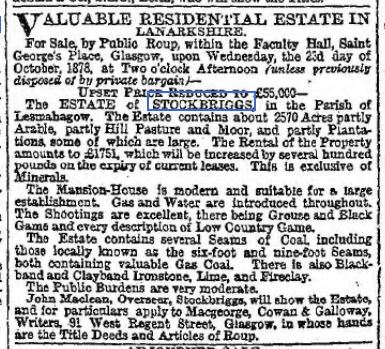
Sale of Stockbriggs. Glasgow Herald 4 Oct 1878. Credit: British Newspaper Archive
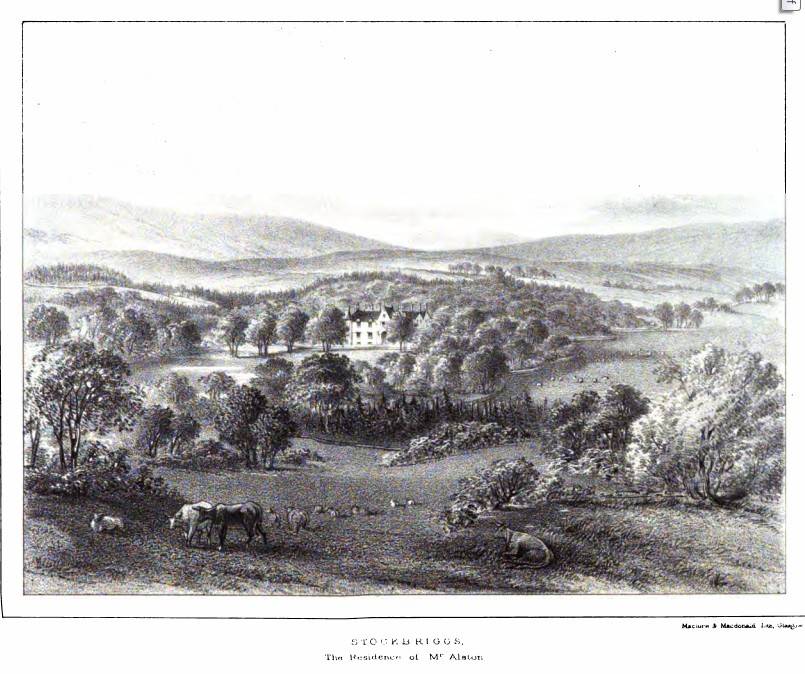
Lithograph of the Stockbriggs Estate, when owned by William Alston, Esq. Credit: Jim Hamilton Heritage Society of Coalburn
In 1881 they were all (including the Fenwicks) recorded at 10 Moray Place, which they presumably still used as their city residence. James died at 10 Moray Place in 1886.
In 1891 the family were gathered at Stockbriggs House enjoying their new status in society; his son John had inherited, and was there with his mother, and his two sisters and their six children.
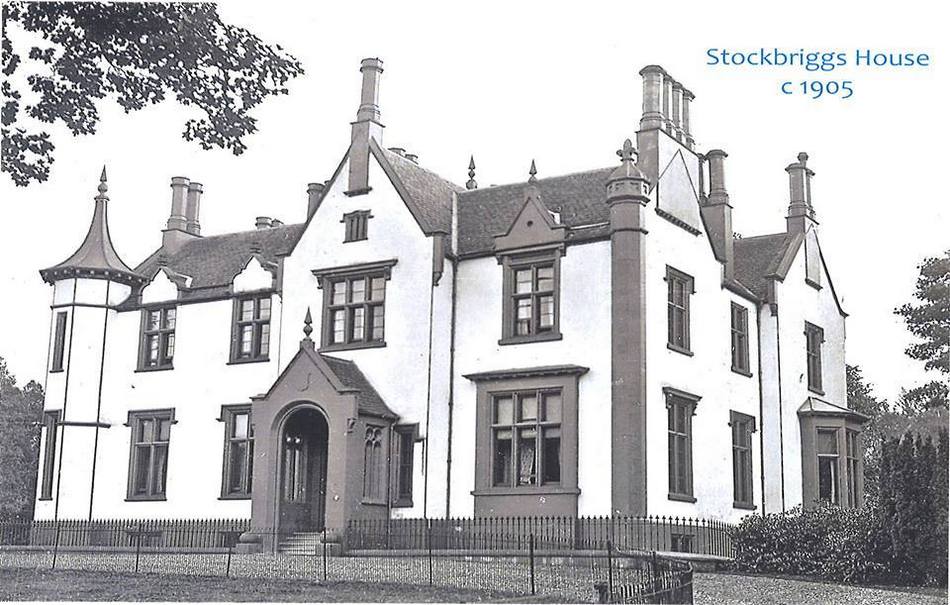
Stockbriggs House 1905. Credit: Jim Hamilton Heritage Society of Coalburn
The Waddell & Son company developed the Auchenbegg and Dalquhandy coal mines on the Stockbriggs estate. However by 1901 John appeared to have shunned the country gent lifestyle. He was living in the more modest house Rosskeen, 4 Elliot Avenue, off Newlands Drive, and was letting out the Stockbriggs estate as a shooting estate to others. I can find no record of him marrying, and he died at Rosskeen in 1931, leaving £250,000 in his estate.
John transferred the company Waddell & Son, including the Auchenbegg and Dalquhandy mines, to his sister Mary’s son, James Waddell McMillan in 1909 .
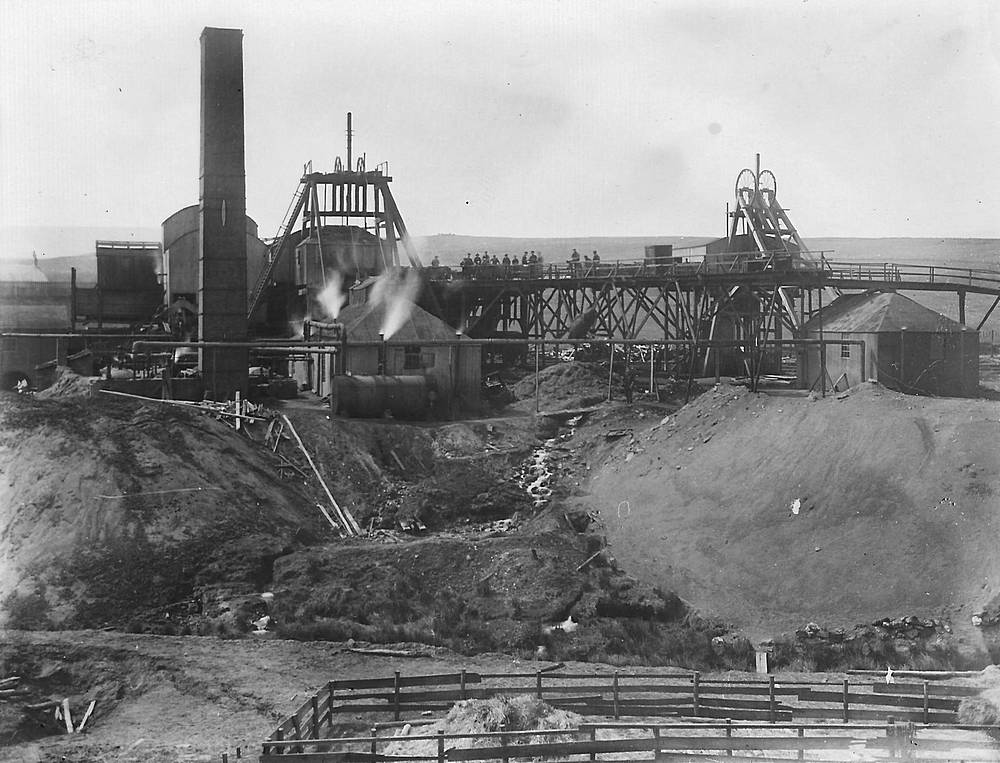
Auchenbegg Colliery 1901. Credit: Jim Hamilton Heritage Society of Coalburn
A 1910 report by the Medical Officer of Health on the condition of miners’ houses at Waddell & Son’s mines on the Stockbriggs estate describes generally satisfactory buldings. It notes Auchenbegg employed 240 men, and Dalquahandy 110 .
In 1914 John passed the Stockbriggs estate to his nephew, Catherine’s son Archibald Thomson, who had an interest in developing the agriculture there, but Archibald died fighting in the Great War in 1917 . The estate then passed to another nephew, Mary’s son and James’ younger brother, John McMillan. A “McMillan” was advertising in the Scotsman for a ploughman at Stockbriggs in 1913.
Mary & Helen Jane were living at Stockbriggs when Helen died young in 1918.
Stockbriggs was advertised for sale 1920 & 1922. The equipment at the Dalquhandy & Auchenbegg collieries there was sold in 1922 due to termination of the lease .
James’ daughters
Jane married Dr Fenwick, as described at 9 Moray Place.
Catherine married William Thomson who worked at Glasgow Rope Works, founded by his father Archibald. The factory was in Shettleston, and they lived at Ferndean close to the factory. They were there in the 1881 census, and Catherine’s sister Mary Waddell was also present, just before she married. William died in 1888 .
Of Catherine’s children, as noted above Archibald died in the Great War, his sister Helen died in the Spanish flu epidemic the following year, and her other daughter Mary Alston Waddell Thomson never married. She appears to have inherited much of the family wealth, and died in Largs, leaving her picture collection to Glasgow. Glasgow Museums have a lengthy obituary for her (though they say she descends from the Alstons of Stockbriggs and this appears to be untrue) .
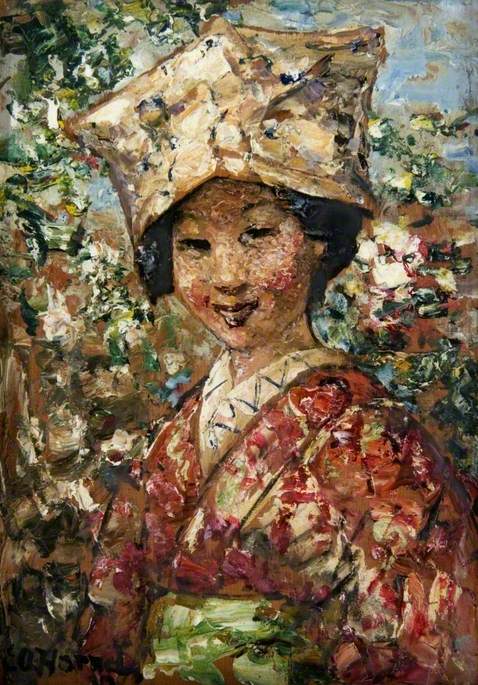
Donated by Mary Alston Waddell Thomson. The Paper Hat by Edward Hornel. Credit: Glasgow Museums
Mary, the youngest daughter, married the Rev Robert Kerr McMillan at 10 Moray Place on 19th April 1881. Robert was the minister at Strathbungo Parish Church. There is much detail regarding Rev McMillan and his role in the development of Strathbungo Parish, in the centenary book by Rev Munro, Strathbungo and its Kirk 1833-1933. They moved to Leslie Road, and had three children.
James Waddell MacMillan (1882-1954) was a coalmaster, continuing the family business of Waddell & Son. He lived in Leslie Road, and later in Giffnock, and was recorded as involved in the Glentaggart Coal Company at the time of its voluntary winding up in 1948 (Edinburgh Gazette 18 Dec 1953). He possibly died the following year.
Robert Kerr McMillan died in 1942 at 18 Leslie Road – previously his father’s home. He was an arts student in the 1901 census. He married Constance Mackenzie and became a solicitor at McMillan & Orr.
The fate of John McMillan is less clear.
Alexander Kirkwood Brown
Alexander Kirkwood Brown, house factor, was initially resident at 7 Moray Place, then No 30, and finally 10 Moray Place. See the blog on 7 Moray Place for more detail.
Thomas Park
Thomas S Park was listed as the owner in the 1920 and 1925 valuation rolls. He was a partner in the Dunfermline Linen Warehouse, a linen specialist shop at 211 Sauchiehall Street’ He had previously lived in Leven Street, and then Shawlands. He was also a local councillor.
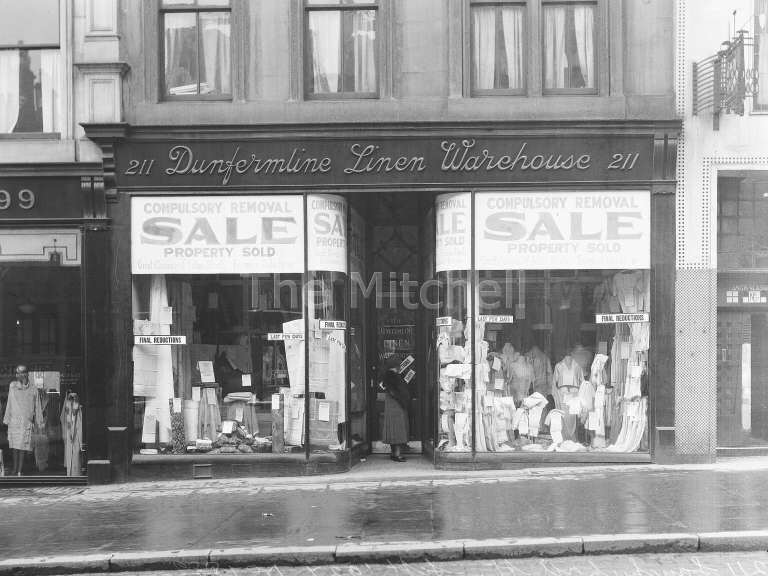
Dunfermline Linen Warehouse at 211 Sauchiehall Street, 1927. Credit: Mitchell Library
His son John Ross Clark, a commercial traveller, also of 10 Moray Place was a bit of a speed freak, and was caught in a speed trap. He was doing 17mph in a 10mph zone in Brechin, and was fined 15 shillings (75p) . Speed kills – but we can only dream of a 10mph limit in Strathbungo now!
Evidently a cavalier motorist, the next year he was caught parking illegally in Lint Riggs, Falkirk while he went to lunch, because “Newmarket Street was choc-a-bloc with motor cars” on Market Day. Ballie Smith wasn’t impressed and fined him 7s 6d (37p) .
Anyway, he didn’t learn; the year after that he took a bend too fast in Cumbernauld, rolled his car down an embankment, and died later in the Glasgow Royal Infirmary .

Cumbernauld Smash. The Scotsman, 1 April 1927

Who could blame him? This motor advert appeared next to the annoucement of his death. We still allow this type of advertising.
Miss I S Grant
Resident in 1939, but I know nothing further about her.
Dance School
Reader Elspeth recalls Miss Marino’s Dance School operating at 10 Moray Place in the 1960s or 70s, where she learned tap and ballet, and Highland dancing. Miss Marino possibly had a daughter, Shona McWhirter? Another commenter suggests the main reception room had a sprung dance floor.
Elspeth lived at No. 33, with the junior monkey puzzle tree, to No. 10’s fully grown one. With No. 10’s now gone, the one at 33 is now the senior monkey puzzle in the area!
And that’s it for 10 Moray Place. Additions and corrections are welcome.
References
{3557955:X6WD49IT};{3557955:9SQRE5V9};{3557955:HQWHR8LV};{3557955:8Y8SAMHR};{3557955:DGXW96FE};{3557955:5BLZRB43};{3557955:PLZ4DAY7};{3557955:55B4ZIKU};{3557955:XZ8C6HC3};{3557955:ULWCTHYL};{3557955:XZ8C6HC3};{3557955:XZ8C6HC3};{3557955:Z7GQIVB4};{3557955:BSFYRPNA};{3557955:WL3H4HKR}
vancouver
asc
0
3320
%7B%22status%22%3A%22success%22%2C%22updateneeded%22%3Afalse%2C%22instance%22%3A%22zotpress-3633311a263bb7cfa288725b22b329b9%22%2C%22meta%22%3A%7B%22request_last%22%3A0%2C%22request_next%22%3A0%2C%22used_cache%22%3Atrue%7D%2C%22data%22%3A%5B%7B%22key%22%3A%22ULWCTHYL%22%2C%22library%22%3A%7B%22id%22%3A3557955%7D%2C%22meta%22%3A%7B%22parsedDate%22%3A%221922-08-02%22%2C%22numChildren%22%3A0%7D%2C%22bib%22%3A%22%3Cdiv%20class%3D%5C%22csl-bib-body%5C%22%20style%3D%5C%22line-height%3A%201.35%3B%20%5C%22%3E%5Cn%20%20%3Cdiv%20class%3D%5C%22csl-entry%5C%22%20style%3D%5C%22clear%3A%20left%3B%20%5C%22%3E%5Cn%20%20%20%20%3Cdiv%20class%3D%5C%22csl-left-margin%5C%22%20style%3D%5C%22float%3A%20left%3B%20padding-right%3A%200.5em%3B%20text-align%3A%20right%3B%20width%3A%201em%3B%5C%22%3E1.%3C%5C%2Fdiv%3E%3Cdiv%20class%3D%5C%22csl-right-inline%5C%22%20style%3D%5C%22margin%3A%200%20.4em%200%201.5em%3B%5C%22%3EDalquhandy%20and%20Auchinbegg%20Collieries%2C%20Coalburn.%20The%20Scotsman%20%5BInternet%5D.%201922%20Aug%202%3B%20Available%20from%3A%20%3Ca%20href%3D%27https%3A%5C%2F%5C%2Fwww.britishnewspaperarchive.co.uk%5C%2Fviewer%5C%2Fbl%5C%2F0000540%5C%2F19220802%5C%2F095%5C%2F0011%27%3Ehttps%3A%5C%2F%5C%2Fwww.britishnewspaperarchive.co.uk%5C%2Fviewer%5C%2Fbl%5C%2F0000540%5C%2F19220802%5C%2F095%5C%2F0011%3C%5C%2Fa%3E%3C%5C%2Fdiv%3E%5Cn%20%20%3C%5C%2Fdiv%3E%5Cn%3C%5C%2Fdiv%3E%22%2C%22data%22%3A%7B%22itemType%22%3A%22newspaperArticle%22%2C%22title%22%3A%22Dalquhandy%20and%20Auchinbegg%20Collieries%2C%20Coalburn%22%2C%22creators%22%3A%5B%5D%2C%22abstractNote%22%3A%22%22%2C%22date%22%3A%222%20Aug%201922%22%2C%22section%22%3A%22%22%2C%22language%22%3A%22%22%2C%22ISSN%22%3A%22%22%2C%22url%22%3A%22https%3A%5C%2F%5C%2Fwww.britishnewspaperarchive.co.uk%5C%2Fviewer%5C%2Fbl%5C%2F0000540%5C%2F19220802%5C%2F095%5C%2F0011%22%2C%22collections%22%3A%5B%22CAR6MXPM%22%5D%2C%22dateModified%22%3A%222022-02-18T13%3A50%3A46Z%22%7D%7D%2C%7B%22key%22%3A%22BSFYRPNA%22%2C%22library%22%3A%7B%22id%22%3A3557955%7D%2C%22meta%22%3A%7B%22parsedDate%22%3A%221926-10-16%22%2C%22numChildren%22%3A0%7D%2C%22bib%22%3A%22%3Cdiv%20class%3D%5C%22csl-bib-body%5C%22%20style%3D%5C%22line-height%3A%201.35%3B%20%5C%22%3E%5Cn%20%20%3Cdiv%20class%3D%5C%22csl-entry%5C%22%20style%3D%5C%22clear%3A%20left%3B%20%5C%22%3E%5Cn%20%20%20%20%3Cdiv%20class%3D%5C%22csl-left-margin%5C%22%20style%3D%5C%22float%3A%20left%3B%20padding-right%3A%200.5em%3B%20text-align%3A%20right%3B%20width%3A%201em%3B%5C%22%3E1.%3C%5C%2Fdiv%3E%3Cdiv%20class%3D%5C%22csl-right-inline%5C%22%20style%3D%5C%22margin%3A%200%20.4em%200%201.5em%3B%5C%22%3EHiggledy-Piggledy%20Car%20Parking.%20Falkirk%20Herald%20%5BInternet%5D.%201926%20Oct%2016%3B%20Available%20from%3A%20%3Ca%20href%3D%27https%3A%5C%2F%5C%2Fwww.britishnewspaperarchive.co.uk%5C%2Fviewer%5C%2Fbl%5C%2F0000733%5C%2F19261016%5C%2F165%5C%2F0007%27%3Ehttps%3A%5C%2F%5C%2Fwww.britishnewspaperarchive.co.uk%5C%2Fviewer%5C%2Fbl%5C%2F0000733%5C%2F19261016%5C%2F165%5C%2F0007%3C%5C%2Fa%3E%3C%5C%2Fdiv%3E%5Cn%20%20%3C%5C%2Fdiv%3E%5Cn%3C%5C%2Fdiv%3E%22%2C%22data%22%3A%7B%22itemType%22%3A%22newspaperArticle%22%2C%22title%22%3A%22Higgledy-Piggledy%20Car%20Parking%22%2C%22creators%22%3A%5B%5D%2C%22abstractNote%22%3A%22%22%2C%22date%22%3A%2216%20Oct%201926%22%2C%22section%22%3A%22%22%2C%22language%22%3A%22%22%2C%22ISSN%22%3A%22%22%2C%22url%22%3A%22https%3A%5C%2F%5C%2Fwww.britishnewspaperarchive.co.uk%5C%2Fviewer%5C%2Fbl%5C%2F0000733%5C%2F19261016%5C%2F165%5C%2F0007%22%2C%22collections%22%3A%5B%22CAR6MXPM%22%5D%2C%22dateModified%22%3A%222022-02-18T13%3A09%3A06Z%22%7D%7D%2C%7B%22key%22%3A%22WL3H4HKR%22%2C%22library%22%3A%7B%22id%22%3A3557955%7D%2C%22meta%22%3A%7B%22parsedDate%22%3A%221927-04-01%22%2C%22numChildren%22%3A0%7D%2C%22bib%22%3A%22%3Cdiv%20class%3D%5C%22csl-bib-body%5C%22%20style%3D%5C%22line-height%3A%201.35%3B%20%5C%22%3E%5Cn%20%20%3Cdiv%20class%3D%5C%22csl-entry%5C%22%20style%3D%5C%22clear%3A%20left%3B%20%5C%22%3E%5Cn%20%20%20%20%3Cdiv%20class%3D%5C%22csl-left-margin%5C%22%20style%3D%5C%22float%3A%20left%3B%20padding-right%3A%200.5em%3B%20text-align%3A%20right%3B%20width%3A%201em%3B%5C%22%3E1.%3C%5C%2Fdiv%3E%3Cdiv%20class%3D%5C%22csl-right-inline%5C%22%20style%3D%5C%22margin%3A%200%20.4em%200%201.5em%3B%5C%22%3EThe%20Cumbernauld%20Motor%20Smash.%20The%20Scotsman%20%5BInternet%5D.%201927%20Apr%201%3B%20Available%20from%3A%20%3Ca%20href%3D%27https%3A%5C%2F%5C%2Fwww.britishnewspaperarchive.co.uk%5C%2Fviewer%5C%2Fbl%5C%2F0000540%5C%2F19270401%5C%2F298%5C%2F0007%27%3Ehttps%3A%5C%2F%5C%2Fwww.britishnewspaperarchive.co.uk%5C%2Fviewer%5C%2Fbl%5C%2F0000540%5C%2F19270401%5C%2F298%5C%2F0007%3C%5C%2Fa%3E%3C%5C%2Fdiv%3E%5Cn%20%20%3C%5C%2Fdiv%3E%5Cn%3C%5C%2Fdiv%3E%22%2C%22data%22%3A%7B%22itemType%22%3A%22newspaperArticle%22%2C%22title%22%3A%22The%20Cumbernauld%20Motor%20Smash%22%2C%22creators%22%3A%5B%5D%2C%22abstractNote%22%3A%22%22%2C%22date%22%3A%221%20April%201927%22%2C%22section%22%3A%22%22%2C%22language%22%3A%22%22%2C%22ISSN%22%3A%22%22%2C%22url%22%3A%22https%3A%5C%2F%5C%2Fwww.britishnewspaperarchive.co.uk%5C%2Fviewer%5C%2Fbl%5C%2F0000540%5C%2F19270401%5C%2F298%5C%2F0007%22%2C%22collections%22%3A%5B%22CAR6MXPM%22%5D%2C%22dateModified%22%3A%222022-02-18T13%3A06%3A29Z%22%7D%7D%2C%7B%22key%22%3A%22Z7GQIVB4%22%2C%22library%22%3A%7B%22id%22%3A3557955%7D%2C%22meta%22%3A%7B%22parsedDate%22%3A%221925-07-10%22%2C%22numChildren%22%3A0%7D%2C%22bib%22%3A%22%3Cdiv%20class%3D%5C%22csl-bib-body%5C%22%20style%3D%5C%22line-height%3A%201.35%3B%20%5C%22%3E%5Cn%20%20%3Cdiv%20class%3D%5C%22csl-entry%5C%22%20style%3D%5C%22clear%3A%20left%3B%20%5C%22%3E%5Cn%20%20%20%20%3Cdiv%20class%3D%5C%22csl-left-margin%5C%22%20style%3D%5C%22float%3A%20left%3B%20padding-right%3A%200.5em%3B%20text-align%3A%20right%3B%20width%3A%201em%3B%5C%22%3E1.%3C%5C%2Fdiv%3E%3Cdiv%20class%3D%5C%22csl-right-inline%5C%22%20style%3D%5C%22margin%3A%200%20.4em%200%201.5em%3B%5C%22%3ETrapped%20motorist%20decides.%20Dundee%20Courier%20%5BInternet%5D.%201925%20Jul%2010%3B%20Available%20from%3A%20%3Ca%20href%3D%27https%3A%5C%2F%5C%2Fwww.britishnewspaperarchive.co.uk%5C%2Fviewer%5C%2Fbl%5C%2F0000164%5C%2F19250710%5C%2F076%5C%2F0005%27%3Ehttps%3A%5C%2F%5C%2Fwww.britishnewspaperarchive.co.uk%5C%2Fviewer%5C%2Fbl%5C%2F0000164%5C%2F19250710%5C%2F076%5C%2F0005%3C%5C%2Fa%3E%3C%5C%2Fdiv%3E%5Cn%20%20%3C%5C%2Fdiv%3E%5Cn%3C%5C%2Fdiv%3E%22%2C%22data%22%3A%7B%22itemType%22%3A%22newspaperArticle%22%2C%22title%22%3A%22Trapped%20motorist%20decides%22%2C%22creators%22%3A%5B%5D%2C%22abstractNote%22%3A%22%22%2C%22date%22%3A%2210%20Jul%201925%22%2C%22section%22%3A%22%22%2C%22language%22%3A%22%22%2C%22ISSN%22%3A%22%22%2C%22url%22%3A%22https%3A%5C%2F%5C%2Fwww.britishnewspaperarchive.co.uk%5C%2Fviewer%5C%2Fbl%5C%2F0000164%5C%2F19250710%5C%2F076%5C%2F0005%22%2C%22collections%22%3A%5B%22CAR6MXPM%22%5D%2C%22dateModified%22%3A%222022-02-18T12%3A58%3A57Z%22%7D%7D%2C%7B%22key%22%3A%22PLZ4DAY7%22%2C%22library%22%3A%7B%22id%22%3A3557955%7D%2C%22meta%22%3A%7B%22parsedDate%22%3A%221899-11-10%22%2C%22numChildren%22%3A0%7D%2C%22bib%22%3A%22%3Cdiv%20class%3D%5C%22csl-bib-body%5C%22%20style%3D%5C%22line-height%3A%201.35%3B%20%5C%22%3E%5Cn%20%20%3Cdiv%20class%3D%5C%22csl-entry%5C%22%20style%3D%5C%22clear%3A%20left%3B%20%5C%22%3E%5Cn%20%20%20%20%3Cdiv%20class%3D%5C%22csl-left-margin%5C%22%20style%3D%5C%22float%3A%20left%3B%20padding-right%3A%200.5em%3B%20text-align%3A%20right%3B%20width%3A%201em%3B%5C%22%3E1.%3C%5C%2Fdiv%3E%3Cdiv%20class%3D%5C%22csl-right-inline%5C%22%20style%3D%5C%22margin%3A%200%20.4em%200%201.5em%3B%5C%22%3EThe%20business%20of%20Waddell%20%26amp%3B%20Son.%20The%20Scotsman%20%5BInternet%5D.%201899%20Nov%2010%3B%20Available%20from%3A%20%3Ca%20href%3D%27https%3A%5C%2F%5C%2Fwww.britishnewspaperarchive.co.uk%5C%2Fviewer%5C%2Fbl%5C%2F0000540%5C%2F19091110%5C%2F199%5C%2F0002%27%3Ehttps%3A%5C%2F%5C%2Fwww.britishnewspaperarchive.co.uk%5C%2Fviewer%5C%2Fbl%5C%2F0000540%5C%2F19091110%5C%2F199%5C%2F0002%3C%5C%2Fa%3E%3C%5C%2Fdiv%3E%5Cn%20%20%3C%5C%2Fdiv%3E%5Cn%3C%5C%2Fdiv%3E%22%2C%22data%22%3A%7B%22itemType%22%3A%22newspaperArticle%22%2C%22title%22%3A%22The%20business%20of%20Waddell%20%26%20Son%22%2C%22creators%22%3A%5B%5D%2C%22abstractNote%22%3A%22%22%2C%22date%22%3A%2210%20Nov%201899%22%2C%22section%22%3A%22%22%2C%22language%22%3A%22%22%2C%22ISSN%22%3A%22%22%2C%22url%22%3A%22https%3A%5C%2F%5C%2Fwww.britishnewspaperarchive.co.uk%5C%2Fviewer%5C%2Fbl%5C%2F0000540%5C%2F19091110%5C%2F199%5C%2F0002%22%2C%22collections%22%3A%5B%22CAR6MXPM%22%5D%2C%22dateModified%22%3A%222022-02-18T12%3A36%3A09Z%22%7D%7D%2C%7B%22key%22%3A%22XZ8C6HC3%22%2C%22library%22%3A%7B%22id%22%3A3557955%7D%2C%22meta%22%3A%7B%22parsedDate%22%3A%222021-12-22%22%2C%22numChildren%22%3A1%7D%2C%22bib%22%3A%22%3Cdiv%20class%3D%5C%22csl-bib-body%5C%22%20style%3D%5C%22line-height%3A%201.35%3B%20%5C%22%3E%5Cn%20%20%3Cdiv%20class%3D%5C%22csl-entry%5C%22%20style%3D%5C%22clear%3A%20left%3B%20%5C%22%3E%5Cn%20%20%20%20%3Cdiv%20class%3D%5C%22csl-left-margin%5C%22%20style%3D%5C%22float%3A%20left%3B%20padding-right%3A%200.5em%3B%20text-align%3A%20right%3B%20width%3A%201em%3B%5C%22%3E1.%3C%5C%2Fdiv%3E%3Cdiv%20class%3D%5C%22csl-right-inline%5C%22%20style%3D%5C%22margin%3A%200%20.4em%200%201.5em%3B%5C%22%3EMary%20Alston%20Waddell%20Thomson%20%281876-1947%29%20%5BInternet%5D.%20Glasgow%20Museums%20Art%20Donors%20Group.%202021%20%5Bcited%202022%20Feb%2017%5D.%20Available%20from%3A%20%3Ca%20href%3D%27https%3A%5C%2F%5C%2Fglasgowmuseumsartdonors.co.uk%5C%2F2021%5C%2F12%5C%2F22%5C%2Fthomson-3%5C%2F%27%3Ehttps%3A%5C%2F%5C%2Fglasgowmuseumsartdonors.co.uk%5C%2F2021%5C%2F12%5C%2F22%5C%2Fthomson-3%5C%2F%3C%5C%2Fa%3E%3C%5C%2Fdiv%3E%5Cn%20%20%3C%5C%2Fdiv%3E%5Cn%3C%5C%2Fdiv%3E%22%2C%22data%22%3A%7B%22itemType%22%3A%22blogPost%22%2C%22title%22%3A%22Mary%20Alston%20Waddell%20Thomson%20%281876-1947%29%22%2C%22creators%22%3A%5B%5D%2C%22abstractNote%22%3A%22%5Cu2018There%20was%20submitted%20a%20letter%20from%20Messrs.%20A.%20and%20J.%20Graham%2C%20writers%2C%20intimating%20that%20the%20late%20Miss%20M.%20A.%20W.%20Thomson%20of%20Ridge%20Park%2C%20Lanark%2C%20had%20bequeathed%20to%20the%20corporation%20a%20collection%20of%20picture%5Cu2026%22%2C%22blogTitle%22%3A%22Glasgow%20Museums%20Art%20Donors%20Group%22%2C%22date%22%3A%222021-12-22T10%3A01%3A00%2B00%3A00%22%2C%22url%22%3A%22https%3A%5C%2F%5C%2Fglasgowmuseumsartdonors.co.uk%5C%2F2021%5C%2F12%5C%2F22%5C%2Fthomson-3%5C%2F%22%2C%22language%22%3A%22en%22%2C%22collections%22%3A%5B%22CAR6MXPM%22%5D%2C%22dateModified%22%3A%222022-02-17T22%3A27%3A01Z%22%7D%7D%2C%7B%22key%22%3A%2255B4ZIKU%22%2C%22library%22%3A%7B%22id%22%3A3557955%7D%2C%22meta%22%3A%7B%22numChildren%22%3A1%7D%2C%22bib%22%3A%22%3Cdiv%20class%3D%5C%22csl-bib-body%5C%22%20style%3D%5C%22line-height%3A%201.35%3B%20%5C%22%3E%5Cn%20%20%3Cdiv%20class%3D%5C%22csl-entry%5C%22%20style%3D%5C%22clear%3A%20left%3B%20%5C%22%3E%5Cn%20%20%20%20%3Cdiv%20class%3D%5C%22csl-left-margin%5C%22%20style%3D%5C%22float%3A%20left%3B%20padding-right%3A%200.5em%3B%20text-align%3A%20right%3B%20width%3A%201em%3B%5C%22%3E1.%3C%5C%2Fdiv%3E%3Cdiv%20class%3D%5C%22csl-right-inline%5C%22%20style%3D%5C%22margin%3A%200%20.4em%200%201.5em%3B%5C%22%3ELesmahagow%20-%20Scottish%20Mining%20Website%20%5BInternet%5D.%20%5Bcited%202022%20Feb%2017%5D.%20Available%20from%3A%20%3Ca%20href%3D%27http%3A%5C%2F%5C%2Fwww.scottishmining.co.uk%5C%2F428.html%27%3Ehttp%3A%5C%2F%5C%2Fwww.scottishmining.co.uk%5C%2F428.html%3C%5C%2Fa%3E%3C%5C%2Fdiv%3E%5Cn%20%20%3C%5C%2Fdiv%3E%5Cn%3C%5C%2Fdiv%3E%22%2C%22data%22%3A%7B%22itemType%22%3A%22webpage%22%2C%22title%22%3A%22Lesmahagow%20-%20Scottish%20Mining%20Website%22%2C%22creators%22%3A%5B%5D%2C%22abstractNote%22%3A%22%22%2C%22date%22%3A%22%22%2C%22url%22%3A%22http%3A%5C%2F%5C%2Fwww.scottishmining.co.uk%5C%2F428.html%22%2C%22language%22%3A%22%22%2C%22collections%22%3A%5B%22CAR6MXPM%22%5D%2C%22dateModified%22%3A%222022-02-17T22%3A18%3A02Z%22%7D%7D%2C%7B%22key%22%3A%22HQWHR8LV%22%2C%22library%22%3A%7B%22id%22%3A3557955%7D%2C%22meta%22%3A%7B%22parsedDate%22%3A%221870-11-12%22%2C%22numChildren%22%3A0%7D%2C%22bib%22%3A%22%3Cdiv%20class%3D%5C%22csl-bib-body%5C%22%20style%3D%5C%22line-height%3A%201.35%3B%20%5C%22%3E%5Cn%20%20%3Cdiv%20class%3D%5C%22csl-entry%5C%22%20style%3D%5C%22clear%3A%20left%3B%20%5C%22%3E%5Cn%20%20%20%20%3Cdiv%20class%3D%5C%22csl-left-margin%5C%22%20style%3D%5C%22float%3A%20left%3B%20padding-right%3A%200.5em%3B%20text-align%3A%20right%3B%20width%3A%201em%3B%5C%22%3E1.%3C%5C%2Fdiv%3E%3Cdiv%20class%3D%5C%22csl-right-inline%5C%22%20style%3D%5C%22margin%3A%200%20.4em%200%201.5em%3B%5C%22%3ESelf-contained%20lodging%20at%20Strathbungo%20for%20sale.%20Greenock%20Advertiser%20%5BInternet%5D.%201870%20Nov%2012%3B%20Available%20from%3A%20%3Ca%20href%3D%27https%3A%5C%2F%5C%2Fwww.britishnewspaperarchive.co.uk%5C%2Fviewer%5C%2Fbl%5C%2F0000970%5C%2F18701112%5C%2F029%5C%2F0003%27%3Ehttps%3A%5C%2F%5C%2Fwww.britishnewspaperarchive.co.uk%5C%2Fviewer%5C%2Fbl%5C%2F0000970%5C%2F18701112%5C%2F029%5C%2F0003%3C%5C%2Fa%3E%3C%5C%2Fdiv%3E%5Cn%20%20%3C%5C%2Fdiv%3E%5Cn%3C%5C%2Fdiv%3E%22%2C%22data%22%3A%7B%22itemType%22%3A%22newspaperArticle%22%2C%22title%22%3A%22Self-contained%20lodging%20at%20Strathbungo%20for%20sale%22%2C%22creators%22%3A%5B%5D%2C%22abstractNote%22%3A%22%22%2C%22date%22%3A%2212%20Nov%201870%22%2C%22section%22%3A%22%22%2C%22language%22%3A%22%22%2C%22ISSN%22%3A%22%22%2C%22url%22%3A%22https%3A%5C%2F%5C%2Fwww.britishnewspaperarchive.co.uk%5C%2Fviewer%5C%2Fbl%5C%2F0000970%5C%2F18701112%5C%2F029%5C%2F0003%22%2C%22collections%22%3A%5B%22CAR6MXPM%22%5D%2C%22dateModified%22%3A%222022-02-17T21%3A07%3A33Z%22%7D%7D%2C%7B%22key%22%3A%22X6WD49IT%22%2C%22library%22%3A%7B%22id%22%3A3557955%7D%2C%22meta%22%3A%7B%22parsedDate%22%3A%221865-02-03%22%2C%22numChildren%22%3A0%7D%2C%22bib%22%3A%22%3Cdiv%20class%3D%5C%22csl-bib-body%5C%22%20style%3D%5C%22line-height%3A%201.35%3B%20%5C%22%3E%5Cn%20%20%3Cdiv%20class%3D%5C%22csl-entry%5C%22%20style%3D%5C%22clear%3A%20left%3B%20%5C%22%3E%5Cn%20%20%20%20%3Cdiv%20class%3D%5C%22csl-left-margin%5C%22%20style%3D%5C%22float%3A%20left%3B%20padding-right%3A%200.5em%3B%20text-align%3A%20right%3B%20width%3A%201em%3B%5C%22%3E1.%3C%5C%2Fdiv%3E%3Cdiv%20class%3D%5C%22csl-right-inline%5C%22%20style%3D%5C%22margin%3A%200%20.4em%200%201.5em%3B%5C%22%3EDeaths%20-%20John%20Angus.%20Caledonian%20Mercury%20%5BInternet%5D.%201865%20Feb%203%3B%20Available%20from%3A%20%3Ca%20href%3D%27https%3A%5C%2F%5C%2Fwww.britishnewspaperarchive.co.uk%5C%2Fviewer%5C%2Fbl%5C%2F0000047%5C%2F18650203%5C%2F082%5C%2F0004%27%3Ehttps%3A%5C%2F%5C%2Fwww.britishnewspaperarchive.co.uk%5C%2Fviewer%5C%2Fbl%5C%2F0000047%5C%2F18650203%5C%2F082%5C%2F0004%3C%5C%2Fa%3E%3C%5C%2Fdiv%3E%5Cn%20%20%3C%5C%2Fdiv%3E%5Cn%3C%5C%2Fdiv%3E%22%2C%22data%22%3A%7B%22itemType%22%3A%22newspaperArticle%22%2C%22title%22%3A%22Deaths%20-%20John%20Angus%22%2C%22creators%22%3A%5B%5D%2C%22abstractNote%22%3A%22%22%2C%22date%22%3A%223%20Feb%201865%22%2C%22section%22%3A%22%22%2C%22language%22%3A%22%22%2C%22ISSN%22%3A%22%22%2C%22url%22%3A%22https%3A%5C%2F%5C%2Fwww.britishnewspaperarchive.co.uk%5C%2Fviewer%5C%2Fbl%5C%2F0000047%5C%2F18650203%5C%2F082%5C%2F0004%22%2C%22collections%22%3A%5B%22CAR6MXPM%22%5D%2C%22dateModified%22%3A%222022-02-17T21%3A02%3A40Z%22%7D%7D%2C%7B%22key%22%3A%225BLZRB43%22%2C%22library%22%3A%7B%22id%22%3A3557955%7D%2C%22meta%22%3A%7B%22numChildren%22%3A1%7D%2C%22bib%22%3A%22%3Cdiv%20class%3D%5C%22csl-bib-body%5C%22%20style%3D%5C%22line-height%3A%201.35%3B%20%5C%22%3E%5Cn%20%20%3Cdiv%20class%3D%5C%22csl-entry%5C%22%20style%3D%5C%22clear%3A%20left%3B%20%5C%22%3E%5Cn%20%20%20%20%3Cdiv%20class%3D%5C%22csl-left-margin%5C%22%20style%3D%5C%22float%3A%20left%3B%20padding-right%3A%200.5em%3B%20text-align%3A%20right%3B%20width%3A%201em%3B%5C%22%3E1.%3C%5C%2Fdiv%3E%3Cdiv%20class%3D%5C%22csl-right-inline%5C%22%20style%3D%5C%22margin%3A%200%20.4em%200%201.5em%3B%5C%22%3Ehttps%3A%5C%2F%5C%2Fwww.casemine.com%20%5BInternet%5D.%20%5Bcited%202022%20Feb%2016%5D.%20Wilsons%20v.%20Waddell%2C%20%5B1876%5D%20SLR%2013_196%20%7C%20Scottish%20Court%20of%20Session%2C%20Judgment%2C%20Law%2C%20casemine.com.%20Available%20from%3A%20%3Ca%20href%3D%27https%3A%5C%2F%5C%2Fwww.casemine.com%5C%2Fjudgement%5C%2Fuk%5C%2F5a8ff81c60d03e7f57eba3f2%27%3Ehttps%3A%5C%2F%5C%2Fwww.casemine.com%5C%2Fjudgement%5C%2Fuk%5C%2F5a8ff81c60d03e7f57eba3f2%3C%5C%2Fa%3E%3C%5C%2Fdiv%3E%5Cn%20%20%3C%5C%2Fdiv%3E%5Cn%3C%5C%2Fdiv%3E%22%2C%22data%22%3A%7B%22itemType%22%3A%22webpage%22%2C%22title%22%3A%22Wilsons%20v.%20Waddell%2C%20%5B1876%5D%20SLR%2013_196%20%7C%20Scottish%20Court%20of%20Session%2C%20Judgment%2C%20Law%2C%20casemine.com%22%2C%22creators%22%3A%5B%5D%2C%22abstractNote%22%3A%22Get%20free%20access%20to%20the%20complete%20judgment%20in%20Wilsons%20v.%20Waddell%20on%20CaseMine.%22%2C%22date%22%3A%22%22%2C%22url%22%3A%22https%3A%5C%2F%5C%2Fwww.casemine.com%5C%2Fjudgement%5C%2Fuk%5C%2F5a8ff81c60d03e7f57eba3f2%22%2C%22language%22%3A%22en%22%2C%22collections%22%3A%5B%22CAR6MXPM%22%5D%2C%22dateModified%22%3A%222022-02-16T19%3A19%3A36Z%22%7D%7D%2C%7B%22key%22%3A%22DGXW96FE%22%2C%22library%22%3A%7B%22id%22%3A3557955%7D%2C%22meta%22%3A%7B%22numChildren%22%3A1%7D%2C%22bib%22%3A%22%3Cdiv%20class%3D%5C%22csl-bib-body%5C%22%20style%3D%5C%22line-height%3A%201.35%3B%20%5C%22%3E%5Cn%20%20%3Cdiv%20class%3D%5C%22csl-entry%5C%22%20style%3D%5C%22clear%3A%20left%3B%20%5C%22%3E%5Cn%20%20%20%20%3Cdiv%20class%3D%5C%22csl-left-margin%5C%22%20style%3D%5C%22float%3A%20left%3B%20padding-right%3A%200.5em%3B%20text-align%3A%20right%3B%20width%3A%201em%3B%5C%22%3E1.%3C%5C%2Fdiv%3E%3Cdiv%20class%3D%5C%22csl-right-inline%5C%22%20style%3D%5C%22margin%3A%200%20.4em%200%201.5em%3B%5C%22%3EMauldslie%20a%20Colliery%2C%20South%20Lanarkshire%2C%20Scotland%2C%20UK%20%5BInternet%5D.%20%5Bcited%202022%20Feb%2016%5D.%20Available%20from%3A%20%3Ca%20href%3D%27https%3A%5C%2F%5C%2Fwww.mindat.org%5C%2Floc-387075.html%27%3Ehttps%3A%5C%2F%5C%2Fwww.mindat.org%5C%2Floc-387075.html%3C%5C%2Fa%3E%3C%5C%2Fdiv%3E%5Cn%20%20%3C%5C%2Fdiv%3E%5Cn%3C%5C%2Fdiv%3E%22%2C%22data%22%3A%7B%22itemType%22%3A%22webpage%22%2C%22title%22%3A%22Mauldslie%20a%20Colliery%2C%20South%20Lanarkshire%2C%20Scotland%2C%20UK%22%2C%22creators%22%3A%5B%5D%2C%22abstractNote%22%3A%22Mine%20Owner%28s%29%3A%5Cn1866-1870%20%20Michael%20Burns%5Cn%5Cn1873%20%20James%20Waddell%5Cn%5Cn1875-1890%20%20James%20Waddell%20%26amp%3B%20Son%22%2C%22date%22%3A%22%22%2C%22url%22%3A%22https%3A%5C%2F%5C%2Fwww.mindat.org%5C%2Floc-387075.html%22%2C%22language%22%3A%22%22%2C%22collections%22%3A%5B%22CAR6MXPM%22%5D%2C%22dateModified%22%3A%222022-02-16T18%3A58%3A57Z%22%7D%7D%2C%7B%22key%22%3A%228Y8SAMHR%22%2C%22library%22%3A%7B%22id%22%3A3557955%7D%2C%22meta%22%3A%7B%22numChildren%22%3A1%7D%2C%22bib%22%3A%22%3Cdiv%20class%3D%5C%22csl-bib-body%5C%22%20style%3D%5C%22line-height%3A%201.35%3B%20%5C%22%3E%5Cn%20%20%3Cdiv%20class%3D%5C%22csl-entry%5C%22%20style%3D%5C%22clear%3A%20left%3B%20%5C%22%3E%5Cn%20%20%20%20%3Cdiv%20class%3D%5C%22csl-left-margin%5C%22%20style%3D%5C%22float%3A%20left%3B%20padding-right%3A%200.5em%3B%20text-align%3A%20right%3B%20width%3A%201em%3B%5C%22%3E1.%3C%5C%2Fdiv%3E%3Cdiv%20class%3D%5C%22csl-right-inline%5C%22%20style%3D%5C%22margin%3A%200%20.4em%200%201.5em%3B%5C%22%3EOvertown%20Station%20Colliery%2C%20North%20Lanarkshire%2C%20Scotland%2C%20UK%20%5BInternet%5D.%20%5Bcited%202022%20Feb%2016%5D.%20Available%20from%3A%20%3Ca%20href%3D%27https%3A%5C%2F%5C%2Fwww.mindat.org%5C%2Floc-387285.html%27%3Ehttps%3A%5C%2F%5C%2Fwww.mindat.org%5C%2Floc-387285.html%3C%5C%2Fa%3E%3C%5C%2Fdiv%3E%5Cn%20%20%3C%5C%2Fdiv%3E%5Cn%3C%5C%2Fdiv%3E%22%2C%22data%22%3A%7B%22itemType%22%3A%22webpage%22%2C%22title%22%3A%22Overtown%20Station%20Colliery%2C%20North%20Lanarkshire%2C%20Scotland%2C%20UK%22%2C%22creators%22%3A%5B%5D%2C%22abstractNote%22%3A%22Mine%20Owner%28s%29%3A%5Cn1860-1865%20%20Waddell%20%26amp%3B%20London%5Cn%5Cn1866-1869%20%20Joseph%20Waddell%5Cn%5Cn1870-1875%20%20James%20%20...%22%2C%22date%22%3A%22%22%2C%22url%22%3A%22https%3A%5C%2F%5C%2Fwww.mindat.org%5C%2Floc-387285.html%22%2C%22language%22%3A%22%22%2C%22collections%22%3A%5B%22CAR6MXPM%22%5D%2C%22dateModified%22%3A%222022-02-16T18%3A57%3A27Z%22%7D%7D%2C%7B%22key%22%3A%229SQRE5V9%22%2C%22library%22%3A%7B%22id%22%3A3557955%7D%2C%22meta%22%3A%7B%22numChildren%22%3A1%7D%2C%22bib%22%3A%22%3Cdiv%20class%3D%5C%22csl-bib-body%5C%22%20style%3D%5C%22line-height%3A%201.35%3B%20%5C%22%3E%5Cn%20%20%3Cdiv%20class%3D%5C%22csl-entry%5C%22%20style%3D%5C%22clear%3A%20left%3B%20%5C%22%3E%5Cn%20%20%20%20%3Cdiv%20class%3D%5C%22csl-left-margin%5C%22%20style%3D%5C%22float%3A%20left%3B%20padding-right%3A%200.5em%3B%20text-align%3A%20right%3B%20width%3A%201em%3B%5C%22%3E1.%3C%5C%2Fdiv%3E%3Cdiv%20class%3D%5C%22csl-right-inline%5C%22%20style%3D%5C%22margin%3A%200%20.4em%200%201.5em%3B%5C%22%3EHandyside%20and%20Henderson%20-%20Graces%20Guide%20%5BInternet%5D.%20%5Bcited%202022%20Feb%2012%5D.%20Available%20from%3A%20%3Ca%20href%3D%27https%3A%5C%2F%5C%2Fwww.gracesguide.co.uk%5C%2FHandyside_and_Henderson%27%3Ehttps%3A%5C%2F%5C%2Fwww.gracesguide.co.uk%5C%2FHandyside_and_Henderson%3C%5C%2Fa%3E%3C%5C%2Fdiv%3E%5Cn%20%20%3C%5C%2Fdiv%3E%5Cn%3C%5C%2Fdiv%3E%22%2C%22data%22%3A%7B%22itemType%22%3A%22webpage%22%2C%22title%22%3A%22Handyside%20and%20Henderson%20-%20Graces%20Guide%22%2C%22creators%22%3A%5B%5D%2C%22abstractNote%22%3A%22%22%2C%22date%22%3A%22%22%2C%22url%22%3A%22https%3A%5C%2F%5C%2Fwww.gracesguide.co.uk%5C%2FHandyside_and_Henderson%22%2C%22language%22%3A%22%22%2C%22collections%22%3A%5B%22CAR6MXPM%22%5D%2C%22dateModified%22%3A%222022-02-12T10%3A10%3A39Z%22%7D%7D%5D%7D
Like this:
Like Loading...




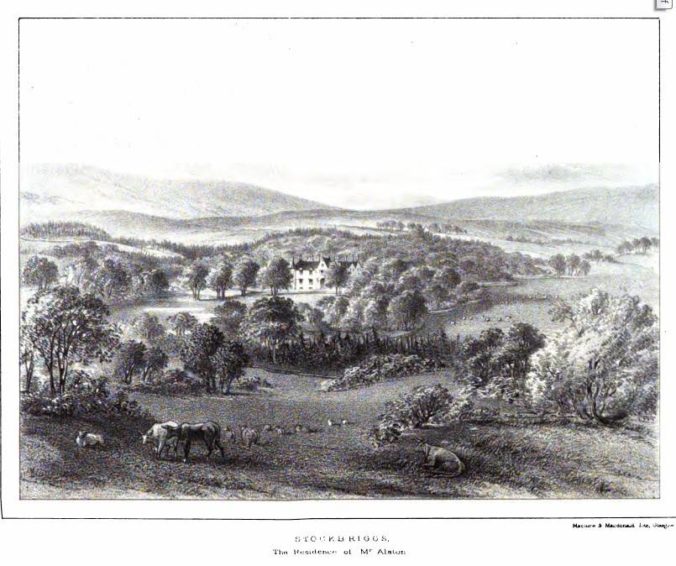








November 12, 2022 at 2:03 pm
Thank you so much for this! My sister and I, and my best pal Sumeera used to cross the wee railway bridge (so recently no more) from the Pollokshields side for Highland dancing lessons every week. The main room did indeed have a sprung wooden dance floor, mirrored walls and barre, and there was a small changing room in behind. I’m often curious to see how the rooms were returned to residential use!
Love this blog, and would love to know if there’s anything similar for Pollokshields, having grown up on a diet of Sheila Ogilvie’s careful researches on the area.
November 12, 2022 at 2:17 pm
The wee railway bridge is still there. Until about February.
There’s https://pollokshieldsheritage.co.uk/ but doesn’t seem to be any recent activity.
December 6, 2022 at 4:00 pm
I also went to the Marino school
Of dance. I took tap and majorettes. My friend and would go on to the metal bridge at the break time and practice our time step it made a magnificent noise with our tap shoes. I remember the house having a very strong smell of cats it’s funny what you remember
August 4, 2024 at 8:23 pm
I went to Miss Marino’s dancing school too. Highland dancing on a Friday evening and then ballet, tap and modern on the Saturday morning. I was about 6/7 when I started and carried on until I finished primary. Her stage name was Jean Marino but her real name was Jean McWhirter and she had a daughter called Seonaid who was also a dancer. Happy memories!